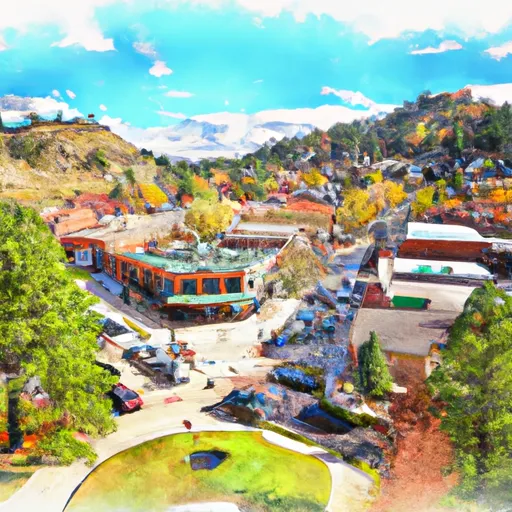-
 Snoflo Premium
Snoflo Premium
Get unlimited access to all our content
With no Ad interruptions! - Start Your Free Trial Login with existing account
Black-Hawk
Eden Index
Climate
6.9
•
Recreation
7.5
•
Community
2.6
•
Safeguard
6.0/10

Black Hawk, Colorado is located in the Rocky Mountains and has a semi-arid climate with cold winters and warm summers. The area is rich in hydrology constituents, including the South Boulder Creek and Clear Creek, which offer opportunities for fishing and kayaking. Black Hawk is known for its many outdoor recreation opportunities, including hiking, mountain biking, and skiing in the nearby mountains. Visitors can also explore local parks, such as Golden Gate Canyon State Park and Mount Evans Wilderness Area. With its stunning mountain scenery, Black Hawk provides a unique and memorable outdoor experience for visitors of all ages.
What is the Eden Index?
The Snoflo Eden Index serves as a comprehensive rating system for regions, evaluating their desirability through a holistic assessment of climate health, outdoor recreation opportunities, and natural disaster risk, acknowledging the profound impact of these factors on livability and well-being.
Climate Health Indicator (CHI): 6.9
Black-Hawk receives approximately
506mm of rain per year,
with humidity levels near 50%
and air temperatures averaging around
5°C.
Black-Hawk has a plant hardyness factor of
5, meaning
plants and agriculture in this region thrive during a short period during spring and early summer. Most
plants will die off during the colder winter months.
By considering the ideal temperature range, reliable water supplies, clean air, and stable seasonal rain or snowpacks, the Climate Health Indicator (CHI) underscores the significance of a healthy climate as the foundation for quality living.
A healthy climate is paramount for ensuring a high quality of life and livability in a region, fostering both physical well-being and environmental harmony. This can be characterized by ideal temperatures, reliable access to water supplies, clean air, and consistent seasonal rain or snowpacks.
Weather Forecast
Streamflow Conditions
South Platte
Area Rivers
South Platte
Snowpack Depths
South Platte
Reservoir Storage Capacity
South Platte
Groundwater Levels
Recreational Opportunity Index (ROI): 7.5
The Recreational Opportunity Index (ROI) recognizes the value of outdoor recreational options, such as parks, hiking trails, camping sites, and fishing spots, while acknowledging that climate plays a pivotal role in ensuring the comfort and consistency of these experiences.
Access to outdoor recreational opportunities, encompassing activities such as parks, hiking, camping, and fishing, is crucial for overall well-being, and the climate plays a pivotal role in enabling and enhancing these experiences, ensuring that individuals can engage in nature-based activities comfortably and consistently.
Camping Areas
| Campground | Campsites | Reservations | Toilets | Showers | Elevation |
|---|---|---|---|---|---|
| Lost Park | 12 | 9,958 ft | |||
| Molly Gulch | 15 | 7,490 ft | |||
| Green Mountain | 6 | 7,615 ft | |||
| Buffalo | 41 | 7,321 ft | |||
| Burning Bear | 13 | 9,643 ft | |||
| Goose Creek | 10 | 7,701 ft | |||
| Spruce Grove - Lake George | 27 | 8,510 ft | |||
| Happy Meadows | 8 | 7,879 ft | |||
| Twin Eagles | 9 | 8,547 ft | |||
| Round Mountain | 15 | 8,531 ft |
Catastrophe Safeguard Index (CSI):
The Catastrophe Safeguard Index (CSI) recognizes that natural disaster risk, encompassing floods, fires, hurricanes, and tornadoes, can drastically affect safety and the overall appeal of an area.
The level of natural disaster risk in a region significantly affects safety and the overall livability, with climate change amplifying these risks by potentially increasing the frequency and intensity of events like floods, fires, hurricanes, and tornadoes, thereby posing substantial challenges to community resilience and well-being.
Community Resilience Indicator (CRI): 2.6
The Community Resilience Indicator (CRI) recognizes that education, healthcare, and socioeconomics are crucial to the well-being of a region. The CRI acknowledges the profound impact of these elements on residents' overall quality of life. By evaluating educational resources, healthcare accessibility, and economic inclusivity, the index captures the essential aspects that contribute to a thriving community, fostering resident satisfaction, equity, and social cohesion.

